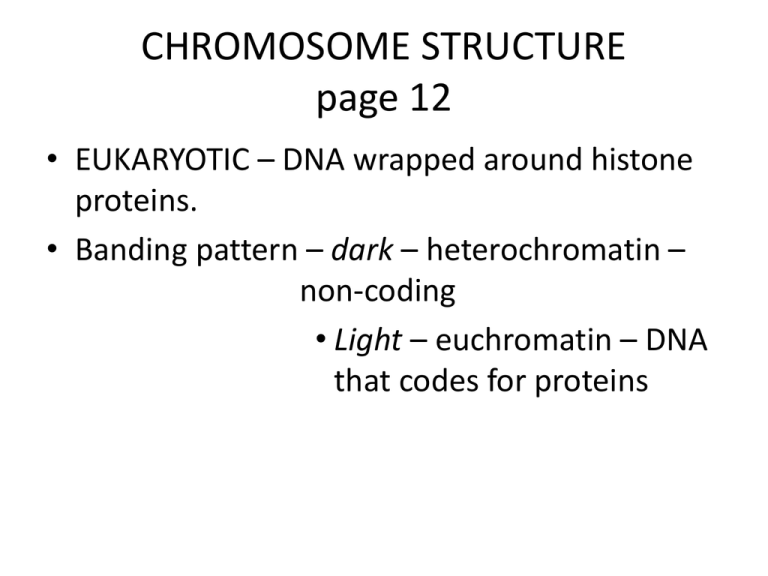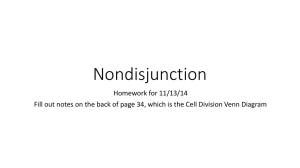fluorescence in situ hybridization
advertisement

CHROMOSOME STRUCTURE page 12 • EUKARYOTIC – DNA wrapped around histone proteins. • Banding pattern – dark – heterochromatin – non-coding • Light – euchromatin – DNA that codes for proteins Prokaryotic chromosomes • DNA wrapped around DNA binding proteins forming a single circular chromosome Eukaryotic chromosome Map of chromosome #4 Chromosomes- sex determination karyotype • a way to show chromosomes in a cell • Usually taken at the metaphase stage • Arranged according to size, centromere position and banding patterns • Can detect unusual chromosome numbers, sizes and banding patterns fluorescence in situ hybridization A modification on karyotyping Fish for cml – 9-22 translocation Examples of diseases that are diagnosed using FISH include: • Prader-Willi syndrome, Angelman syndrome, 22q13 deletion syndrome, chronic myelogenous leukemia, acute lymphoblastic leukemia, Cri-du-chat, Velocardiofacial syndrome, and Down syndrome. Sky karyotyping • Provides a color code to identify particular chromosomes The Cell Cycle page 10 Mitosis Meiosis • • • • • • Occurs in sexually reproducing organisms Produces haploid gametes from diploid cells Occurs in two stages Meiosis I – homologous pairs separate Meiosis II – chromatids separate Four haploid gametes are produced ( for sperm cells / three polar bodies and one ovum) Stages of Meiosis MUTATION page 21 L. CHROMO SOMAL DISORDERS IN NUMBER AND THEIR CONSEQUENCES 1.NONDISJUNCTION VS. MOSAICISM VS. CHIMERA • NONDISJUNCTION - FAILURE OF HOMOLOGOUS CHROMOSOMES TO SEPARATE IN MEIOSIS MOSAICISM - RESULTS WHEN HOMOLOGOUS CHROMOSOMES FAIL TO SEPARATE IN MITOSIS. FROM ONE FERTILIZED EGG u CHIMERA - RESULTS FROM THE FUSION OF TWO CELL LINES - EITHER FROM A DOUBLE FERTILIZATION OR FROM THE FUSION OF TWO ZYGOTES. THE GENOTYPE XX/XY IS FORMED EITHER FROM THE EGG BEING FERTILIZED BY AN X SPERM & A Y SPERM, OR FROM THE FERTILIZED EGG & FERTILIZED POLAR BODY FUSING 2. PLOIDY • AN EXTRA COMPLETE SET OF CHROMOSOMES; 3N- TRIPLOID; 4N TETRAPLOID; USUALLY LETHAL, BUT MAY OCCUR IN HUMAN LIVER CELLS • Induced in plants (using colchicine) to produce Seedless varieties 3. SOMY • INVOLVES NONDISJUNCTION IN A PAIR OF CHROMOSOMES, EX. MONOSOMY & TRISOMY a. AUTOSOMAL TRISOMIES • TRISOMY 21 - DOWN’S SYNDROME, occurs in all population subgroups and in chimpanzees • TRISOMY 18 - EDWARD’S SYNDROME few survive, then only a few weeks, occurs 4:1 in females:males • TRISOMY 13 - PATAU’S SYNDROME most die before the age of three months b. GONOSOMAL ABNORMALITIES IN NUMBER • Turner’s Syndrome - XO a.k.a. gonadal dysgenesis u u Klinefelter’s Syndrome - XXY, XXXY… a.k.a. seminiferous tubule dysgenesis Polysomal X - Triple 47 XXX, Tetra 48 XXXX, Penta 49 XXXXX… a.k.a. “Super Female” tetra, penta - mental retardation • XYY - due to a nondisjunction in male germ cell, or a mitotic nondisjunction in zygote male tall with severe acne, was once believed to be correlated with criminal behavior, those advocating a eugenic philosophy proposed testing for and isolating the “genetic criminals” before they do society harm. M. CHROMOSOME TYPES • METACENTRIC SUBMETACENTRIC ACROCENTRIC CHROMOSOME TYPES (CONT.) • TERMINOLOGY OF THE ARMS p - short arm q - long arm N. CHROMOSOMAL DISORDERS IN STRUCTURE u 1. INVERSIONS - USUALLY DO NOT AFFECT THE GENOTYPE OF THE ORGANISM, THEY DO HOWEVER AFFECT LINKAGE GROUPS. 2. TRANSLOCATIONS • A. RECIPROCAL - AN EXCHANGE BETWEEN NON HOMOLOGOUS CHROMOSOMES • (1) ANEUCENTRIC- PRODUCES DICENTRIC AND ACENTRIC CHROMOSOMES, ALMOST NEVER SURVIVE THE NEXT DIVISION • (2) EUCENTRIC - EACH RESULTING CHROMOSOME HAS ONE CENTROMERE. MOST COMMON TYPE OF TRANSLOCATION. PHILADELPHIA CHROMOSOME • FOUND IN PATIENTS WITH CHRONIC GRANULOCYTIC LEUKEMIA - A TRANSLOCATION BETWEEN 22 & 9. THE LONG ARM PORTION OF 22 (22q) IS LOST AND THE LONG ARM OF 9 (9q) GAINS. ROBERTSONIAN TRANSLOCATION/ FUSION • TRANSLOCATIONS OF UNEQUAL INTERCHANGES BETWEEN ACROCENTRIC CHROMOSOMES (14 & 21) SAME GENETIC MATERIAL, BUT A DECREASE IN # OF CHROMOSOMES 3. DELETIONS • a) partial monosomy ex. Wolf Hirschhorn Syndrome »4p»deletion of the short arm of chromosome #4 »defect of midline fusion Cats Cry Syndrome - Cri-du-chat • • • • • 5pmental and motor disorder growth retardation simian fold in the hands microcephaly Refractory Anemia Syndrome • 5q• increased platelet count Wilms Tumor • • • • • 11paniridia ambiguous genitalia mental retardation kidney malignancy Retinoblastoma • 13q• DELETION OF TUMOR SUPPRESSOR GENE RESULTS IN TUMORS IN THE EYE






